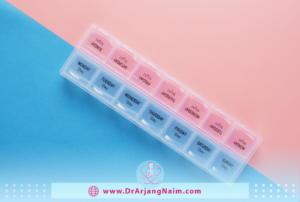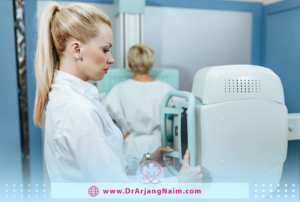Breast cancer is one of the most common types of cancer that affects women worldwide. While the exact cause is still not fully understood, several studies have identified risk factors that may increase the likelihood of developing the disease.
It should be remembered that the presence of these risk factors does not necessarily mean that a person will develop breast cancer. Similarly, the absence of risk factors does not guarantee immunity from disease. Living a healthy lifestyle and participating in regular screening programs can help reduce your overall risk.
Breast anatomy
The human breast is a complex organ composed of several different tissues. Here’s a breakdown of the main parts:
- Fatty tissue: This is the major component of the breasts and determines their size. The amount of fatty tissue varies among women and can also fluctuate throughout a woman’s lifetime.
- Glandular tissue (lobules): The breasts’ milk-producing glands are arranged in 15-20 lobes like grape bunches. Each lobule is made up of smaller lobules that end in tiny sacs called alveoli, which are responsible for milk production.
- Milk ducts (lactiferous ducts): These thin tubes carry milk from the lobules to the nipple. Each lobe has several lactiferous ducts, all converging at the nipple.
- Nipple: The nipple is a protuberance at the center of the breast. It is surrounded by a darker area of skin called the areola. The nipple contains tiny muscles that can erect the nipple in response to stimulation (such as cold or touch).
- Areola: The areola is the darker-colored area of skin surrounding the nipple. It contains sebaceous glands, which produce oil to lubricate the nipple and areola.
- Cooper’s ligaments: These supportive ligaments, made of connective tissue, extend from the chest wall to the breast tissue. They help keep the breasts in place.
In addition to these structures, the breasts contain blood vessels, lymph vessels, and nerves. The blood vessels supply the breasts with blood, while the lymph vessels help to drain waste products from the breasts. The nerves provide sensation to the breasts.
What causes cancer?
Cancer begins in cells, which are the basic building blocks of tissue. The tissue is found in the breast and other parts of the body. Sometimes, the process of cell growth goes wrong, and new cells are formed when the body doesn’t need them, and old or damaged cells don’t die as they should. When this happens, the accumulation of cells often forms a mass of tissue called a mass, growth, or tumor.
Breast cancer is a disease that arises when malignant tumors form in the breast. The cancerous cells can spread by breaking away from the original tumor and entering blood vessels or lymph vessels that connect to tissues throughout the body.
When cancer cells move to other parts of the body and start to damage other tissues and organs, this process is known as metastasis. Breast cancer is a disease that arises when malignant tumors form in the breast. The cancerous cells can spread by breaking away from the original tumor and entering blood vessels or lymph vessels that connect to tissues throughout the body.
What is the risk factor?
Anything that increases the risk of developing a disease is called a risk factor. Different cancers have different risk factors. Having one or more of these risk factors does not mean that you will get breast cancer. Many people with these factors will never develop it; some without risk factors will create it.

Being overweight or obese
Women who are overweight after menopause have a higher risk of developing breast cancer than women who are not overweight. Men also have an increased risk of breast cancer if they are overweight or obese. For both men and women, the risk increases with more weight gain.
Body mass index (BMI) measures height and weight to determine a healthy weight. For most adults, the ideal BMI is between 18.5 and 24.9. Being overweight means having a BMI between 25 and 30. Obesity means being very overweight with a BMI of 30 or higher.
Maintaining a healthy weight reduces the risk of 13 types of cancer, including breast cancer. Ways to maintain a healthy weight include physical activity and a healthy, balanced diet.
Alcohol
Drinking alcohol increases the risk of breast cancer in women. This risk increases with each additional unit of alcohol per day. The number of units of a drink depends on the size of the drink and the volume of alcohol. There is no safe level of alcohol, so the more you can reduce it, the lower your risk.

Contraceptive pill
By taking birth control pills, the risk of breast cancer increases very slightly. This increased risk returns to an average of ten years after stopping its use.
Remember that breast cancer is rare in young women. Most women who take the pill are in their late teens, twenties, and early thirties. So, this small increase in risk over the time that women take the pill means very few cases of breast cancer.
Hormone replacement therapy (HRT)
Many women use hormone replacement therapy to alleviate menopausal symptoms. There are two main types of HRT:
- Combined HRT (progesterone + estrogen)
- Estrogen-only HRT
The risk of breast cancer increases with the use of any type of HRT (but this risk is very low). The risk of breast cancer is higher when using combined HRT compared to estrogen-only HRT.
The longer you use HRT, the higher your risk of breast cancer. But it will decrease over time when you stop using it. For many people, the benefits of taking HRT can outweigh the risks.
Getting old
Most breast cancers occur in women over the age of 50 and are less common in women under the age of 40.
Family history and inherited genes
Some people have a higher risk of breast cancer than the general population because other family members have had certain cancers. A diagnosis of breast cancer in a sister, mother, or daughter increases the risk of developing breast cancer. The risk is higher when more close relatives have had breast cancer or if a relative under the age of 50 has had breast cancer.
Because cancer is so common, most families have at least one person who has or has had cancer. Some people have an increased risk of developing breast cancer due to an inherited genetic defect. We know about several gene defects that can increase the risk of breast cancer, and there are tests for some of them. Having one of these faulty genes means you’re more likely to develop breast cancer than someone who doesn’t have it.
BRCA1 and BRCA2 genes
All people have the BRCA1 and BRCA2 genes. BRCA stands for the BReast CAncer gene. These genes prevent the cells of our body from growing and dividing out of control. If there is a defect (mutation) in these genes, the cells can grow out of control, which can lead to the development of several cancers, including breast cancer.
BRCA1 and BRCA2 gene defects are not common. Only 1 in 450 people have a defective BRCA1 or BRCA2 gene. Examples of other inherited genetic defects that may increase the risk of breast cancer include:
- PALB2 gene
- ATM gene
- CHEK2 gene
- Li-Fraumeni syndrome
- Peutz Jeghers Syndrome
- PTEN hamartoma tumor syndrome
X–rays and radiotherapy (ionising radiation)
Ionizing radiation includes tests such as X-rays and CT scans and treatments such as radiotherapy.

X-rays and mammography
Exposure to radiation increases the risk of many types of cancer. Today, doctors keep medical radiation exposure as low as possible. They only do X-rays or CT scans if they need to. And the amount of radiation used is very low.
Radiotherapy
Radiotherapy treatment for breast cancer slightly increases the risk of developing breast cancer in the other breast. But this small risk is balanced by the need to treat the underlying breast cancer.
Suppose you have had radiotherapy to the chest area to treat another type of cancer. In that case, your risk of developing breast cancer is higher than in people who have not had radiotherapy.
Dense breast tissue
The risk of breast cancer is more significant in women with dense breast tissue due to a higher concentration of breast cells and connective tissue and less fat. The risk of breast cancer is more significant in women with dense breast tissue due to a higher concentration of breast cells and connective tissue and less fat.
The bottom line
When you’re told you have breast cancer, it’s natural to wonder what could have caused it. But no one knows the exact causes of breast cancer. Doctors rarely know why one woman gets breast cancer, and another doesn’t, and most women with breast cancer never know the exact cause. What we do know is that breast cancer is always caused by damage to the cell’s DNA.
Breast cancer is a serious disease, but with early detection through screening and self-examination, it is highly treatable. While some risk factors, such as age, are beyond your control, others, such as weight and lifestyle, are manageable. Knowing the signs and symptoms is important for early detection, so don’t hesitate to talk to your doctor if you notice any changes.
Additional questions
- What are the stages of ovarian cancer?
Ovarian cancer stages are determined by how far the cancer has spread from the ovaries. Staging helps doctors decide on the best course of treatment. Doctors use the FIGO staging system, which considers factors like the size of the tumor, spread to lymph nodes, and spread to distant organs. Here’s a breakdown of the stages:
- Stage I: The cancer is confined to one or both ovaries. This is considered the earliest and most treatable stage.
- Stage II: The cancer has spread to the uterus and fallopian tubes or other tissues within the pelvis.
- Stage III: The cancer has spread to the lymph nodes in the abdomen or groin or to the lining of the abdomen (peritoneum).
- Stage IV: The cancer has spread to distant organs, such as the lungs or liver.
- What are the stages of ovarian cancer?
- Breast cancer
- Colorectal cancer
- Lung cancer
- Endometrial cancer
- Cervical cancer
- Ovarian cancer
- Does breastfeeding reduce cancer?
Research shows that mothers who breastfeed have a reduced risk of breast cancer before and after menopause.
- What is the best breast check?
While mammograms are the most effective tool for finding breast cancer early, they aren’t perfect. Breast self-exams (BSE) can help you be aware of any breast changes. The best approach is a combination of both.
- What is a normal breast?
Normal breasts come in all shapes and sizes! Size, shape, and even lumpiness can vary depending on you. The key is to be familiar with your baseline to notice any changes. If something seems off, talk to your doctor!
References
https://www.cancerresearchuk.org/about-cancer/breast-cancer/risks-causes/risk-factors
https://www.nationalbreastcancer.org/breast-cancer-myths/
https://upmc.it/en/blog/cancer-care/breast-cancer-risk-factors
https://www.bcrf.org/risk-factors-for-breast-cancer/




